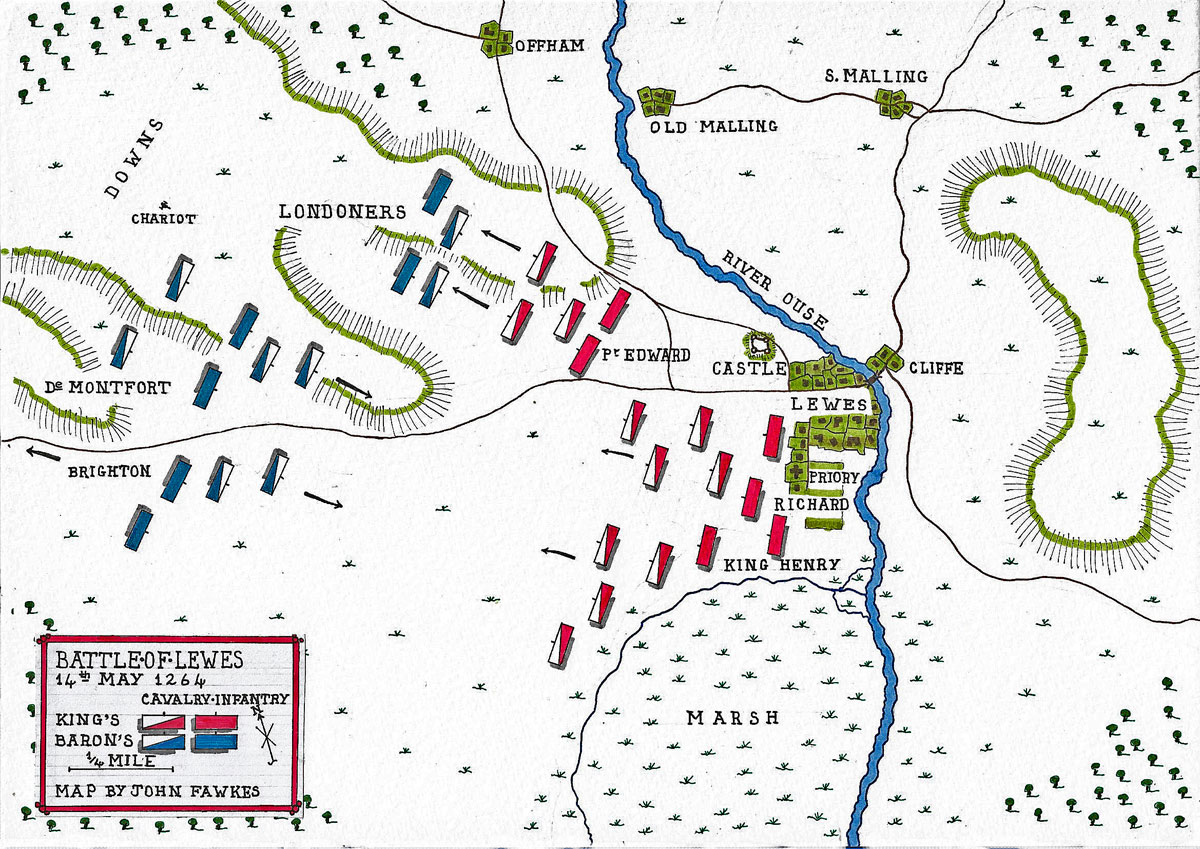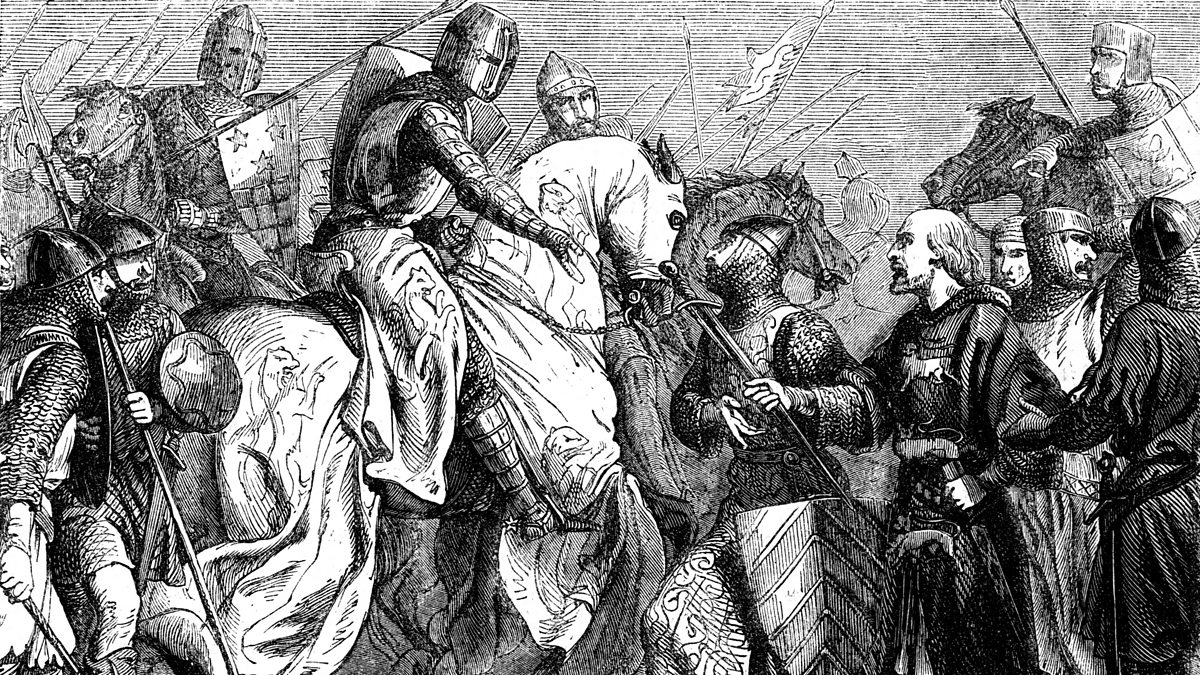Battle of Lewes
Background
In April of 1264, Pope Urban IV absolved King Henry III from his oath to observe the Provisions of Oxford, established in 1258, to resolve a dispute between the King and his barons. The provisions were designed to ensure the King adhered to the rule of law and governed with his barons' advice, allowing them to press their concerns in opposition to the monarchy at three parliaments held each year.
After winning the Battle of Northampton in April, royalist forces under King Henry III had reached Lewes by May. King Henry III was encamped at St. Pancras Priory with an infantry force. In contrast, his son, Prince Edward, was encamped at Lewes Castle with the cavalry, some 500 yards to the north.

Simon de Montfort, 6th Earl of Leicester, attempted a settlement with the King to negotiate a truce. De Montfort sent a delegation consisting of the Bishop of Chichester and several friars with a proposal to reverse the terms of the Provisions of Oxford and a substantive offer of thirty thousand pounds, a considerable sum of money for that period.
The King refused the proposal as even a watered-down version of the Provisions of Oxford would impose on his authority as King. De Montfort then orchestrated a night march from Fletching to Offham Hill, surprising the royalists and making camp for the night.
Battle
Despite being outnumbered, the baronial forces under de Montfort held the higher ground. Their bravery was symbolized by the white crosses they wore to distinguish themselves from the royalists and to solicit favor from God.
Simon de Montfort demonstrated his strategic prowess by dividing his forces into four parts. His son, Henry de Montfort, and John de Burgh were entrusted with one-quarter. Gilbert de Clare commanded the center quarter, comprising John FitzJohn and William of Montchensy. Nicholas de Segrave led the third quarter, comprising Henry de Hastings and Londoners. Simon de Montfort led the fourth quarter, strategically held in reserve, with Thomas of Pelveston, the London constable.
The royalist forces consisted of Henry III commanding the left, Prince Edward, William de Valence, 1st Earl of Pembroke, Guy de Lusignan, John de Warenne, 6th Earl of Surrey, and Roger Mortimer on his right. Richard, the King's brother and 1st Earl of Cornwall, and his son, Henry of Almain, commanded the King's center, which was also bolstered by notable Scottish magnates Robert Bruce, John Baliol, and John Comyn. Cornwall's numbers included troops of Scottish spearmen and John FitzAlan and Henry Percy retinues. The King led the left flank personally with support from Humphrey (IV) de Bohun, Earl of Hereford.

On May 14th, 1264, the Battle of Lewes was initiated with a bold move by the baronial forces. They launched a surprise attack at dawn, catching royalist foragers off guard as they gathered provisions. The battle unfolded with Prince Edward leading a cavalry charge against Segrave's Londoners. The Prince's calvary of knights advanced in line with lances couched and smashed into the mounted screen of men fronting the footmen. John Gifford was taken, and several Londoners were slain. At the same time, the Earl of Oxford, Geoffrey de Lucy, and Humphrey (V) de Bohun retreated from the battlefield. The rest hastily retreated up the slope of the hill, pulling Edward's men away from the rest of the King's army.
This left the King unsupported by cavalry, forcing him to launch an attack with his center forces straight up Offham Hill. The fighting was hand-to-hand and fierce, with both sides drawing apart from time to time to rest and satisfy their raging thirst before re-engaging in battle. Illustrations from the time of the battle show severed limbs and heads scattered over the field. Richard of Cornwall's men faltered, but Henry's men fought on until de Montfort's men in reserve arrived and forced the King to retreat. De Montfort's standard-bearer and Ralph Haringod fell in the mele.
The King's men were forced down the hill into Lewes, where they engaged in a fighting retreat to Lewes Castle and the priory. Two of the King's horses were killed from under him. Many royalists were not as lucky, being pushed back into the marshy land before the River Ouse. Some swam to safety while others, like Fulk FitzWarin, drowned or were sucked whole into the mud. Richard, Earl of Cornwall, took refuge in a windmill as the battle rolled past him. Richard was captured and later incarcerated in Kenilworth Castle. Several others were also taken, including Robert Bruce and John Comyn.

The King retreated to Lewes Castle, whose men fended off any attempts at an escalade. They were beaten but held their ground. Edward returned with his cavalry and launched a counterattack. However, with the town ablaze and many of the King's supporters having fled, the battle had shifted in favor of the barons. This, coupled with the capture of the King, led Edward to accept de Montfort's offer of negotiations.
Aftermath
The King was forced to sign the Mise of Lewes, which has been lost to history. Henry was also forced to accept the Provisions of Oxford. Prince Edward remained a hostage of the barons for almost a year. Several other royalist noblemen were taken prisoner, including Richard of Cornwall, Humphrey de Bohun, Henry of Almain, and Philip Marmion. Roger Mortimer, James of Audley, and Roger of Leybourne were granted their freedom.
Following the defeat at the Battle of Lewes, some of King Henry III's supporters fled south and took refuge in Pevensey Castle. Simon de Montfort's son, laid siege to the castle, but could not take it.
Simon de Montfort was now in a position of ultimate power, which would last until Prince Edward's eventual escape and de Montfort's defeat at the Battle of Evesham.















